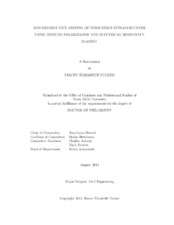| dc.description.abstract | As of September 2007, there were over 67,000 U.S. bridges in the National Bridge Inventory classified as having unknown foundations. The bridges spanning rivers are of critical importance due to the risks of potential scour. In fact, over half of all bridge collapses are due to scour. Not only are these failures costly, they can be deadly for the traveling public. On April 5, 1987, ten people were killed in New York when a pier collapsed on the Schoharie Creek Bridge causing two spans of the deck to fall into the creek. Several other fatal collapses have occurred since the Schoharie Creek Bridge failure. Detecting scour is only part of the assessment that must take place to determine risk of failure and knowing the foundation depth is a critical component of the assessment. While this issue is not new, current techniques are typically invasive or costly.
This research explores the feasibility and effectiveness of induced polarization (IP) and electrical resistivity imaging (ERI), near surface geophysical methods, for determining the depth of unknown foundations. In this work, forward models are created to ascertain the effects of the bridge layout on data quality such as varying depths and the impact of adjacent foundations on the foundation in question. Next, an experimental study is conducted at a National Geotechnical Experimentation Site (NGES) to further identify key parameters for the testing design and setup in order to obtain optimal surveys of bridge foundations. The conclusions of the forward modeling and NGES investigations are used to plan the field surveys on four bridges with known foundations. The outcomes of the four bridges show that IP and ERI can be used in concert with one another to estimate the type and depth of bridge foundations. The results of the field surveys are used to create a probability of non-exceedance curve for future predictions of unknown bridge foundations using the methods described in this research. | en |


